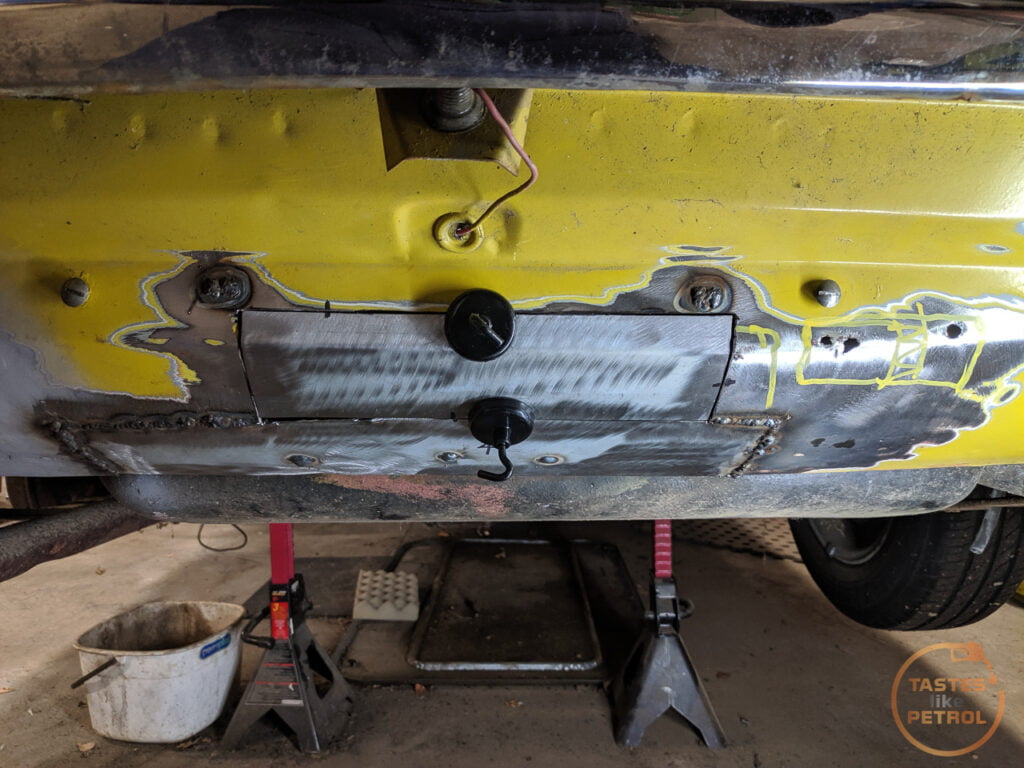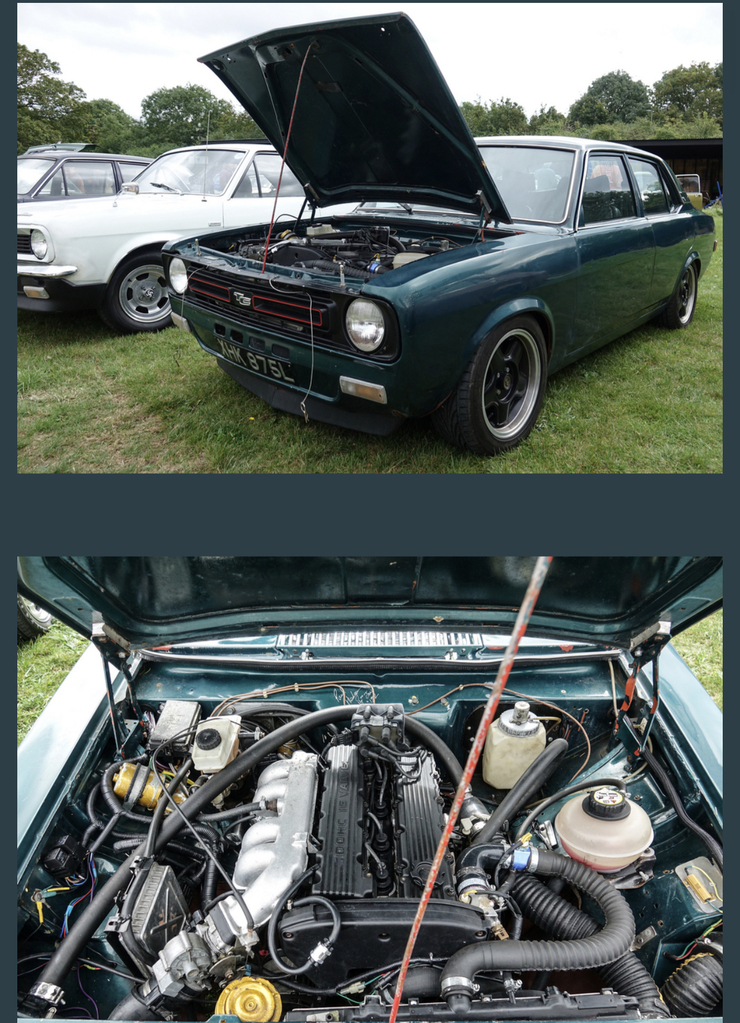Having run out of MIG gas, which then nuked my momentum and motivation on the bodywork repairs, I decided to change path, and do something I actually enjoy; mechanical and electrical work.
Ages ago, gosh, back in 2021 now, I
flushed and cleaned out the cooling system. This was pretty nasty, with lots of brown sludge.

I removed the radiator and reverse flushed it with the hose, which got a lot more sludge out. As it turned out though, the radiator was trash. The core was all rotting away, and I ended up poking a hole in it with a screwdriver when doing up a hose clamp



After looking at various options, of which there were... none, I ended up having the original radiator recorded at great expense by a local firm. A recored radiator means the radiator is rebuilt using a new center core (with the fins and pipes) and reuses the existing end tanks and mounting straps.

Along with the new core, I had them add a bung under the top radiator hose (the hottest point in the radiator) to fit a temperature sensor for my electric fan controller

I did some quick measurements and decided to go with a 10" fan, which was far too small. I later changed to a 12" fan.

I've had this sitting in a box for months, waiting for me to get my A into G and make more progress. One thing that was stopping me, was that I needed to fit an electric fuel pump and remove the old fixed engine-powered fan (not even a viscous clutch fan, this bad boy spun at engine RPM no matter what; I don't have that much faith in 50 year old plastic).
The fan was easy, it's just bolted to the front of the waterpump with a spacer. I removed the fan and spacer, cut some new bolts shorter to hold the pulley on and not hit the waterpump, and that was done.



The fuel pump was a bit harder. I needed to find a suitable location to mount the pump and then run the hoses.
The pump I went with is a Fuelflow 015 piston pump. It's happy to be mounted almost anywhere, at any angle and has the low pressure output required for the SU carb. Its a nice neat little unit; it even has rubber mounted feet


My plan was to mount it on the inner guard, on the Lh side of the car, running the hose feeding the pump under the radiator. Before I started any of the mounting, I grabbed some hose and ran it more or less how it would be once fitted, and directed it into a jug, just to make sure the pump could pull fuel all the way from the tank, through the filter and pump it up higher than the engine.

The answer was yes, easily.
I drilled a couple of holes in the inner guard, and mounted the pump with a couple of rivnuts

And ran the hose along the radiator support, using a pair of rubber-lined P-Clips to secure it (also using rivnuts - I love rivnuts)

The outlet hose was run from the pump to the carb inlet

And a fuel filter was fitted on the other side, before the pump (as per the instructions). Oh, and a nice new drive belt was fitted, probably for the first time in 15-20 years, maybe if ever.

The next step was to remove the old mechanical pump. It lives up under the alternator on these early 1750 engines (later ones are mounted up on the valve cover)

It's held to the sump with two studs. Yes, like the oil filter, it's mounted to the side of the sump.

Be careful when removing the pump to catch the pushrod that drives the pump (and if you're refitting the pump, make sure it's fitted). It's the straight rod on the right in the above photo. There is also a spacer block, which has gaskets on either side of it.
The old pump was literally leaking everything, from everywhere. You can follow the trail down the sump to the back



Using an old gasket I carefully removed, I copied it to some scrap steel and made a blanking plate

Which I painted black with the quickest shot of black paint. A pair of new gaskets were cut from gasket sheet; one to go on either side of the spacer. You could do without the spacer if you spaced the nuts on the studs since the studs aren't threaded to their base, but it's easier to just fit the spacer. Technically you don't need two gaskets either, just the one between the spacer and sump should suffice.

I still needed a couple of washers to space the nuts out anyway

The stud closest to the filter needed an extra washer, as someone had stripped the thread. Probably why the fuel pump leaked.
One bonus to removing the mechanical pump is getting rid of the dodgy fuel hose that used to run across the front of the sump

I replaced this hose very early on, but I still didn't like it there. According to the manual, it should have a hardline from the pump, not a hose, which makes a lot of sense, but obviously someone "fixed" this at some point.
The last thing to do was to wire the pump, but I wanted to get the radiator in first so I knew where the wires could run.
A note before talking about the radiator. A while ago, while the radiator was getting recored, I flushed the block. There is a block drain at the back of the block above the starter

I used a small funnel in the thermostat housing to pour water straight into the head. I got a ton of brown sludge out this way, and flushed through litres of water until it ran clear

I did this because I really didn't want to risk filling the new radiator with sludge from the block.
The radiator was quite straightforward. Fit right into the factory mounting points, and the 12" fan clears everything (or would have if I had mounted it slightly to the right. As it was, it just touched a bend on the top hose. I cut a few mm off the thermostat end of the hose to move it away from the fan).

I hated the old bottom hose and really didn't want to refit it. Because the car is running the more available Maxi/Allegro water pump, which has the outlet on a different angle, you cannot run the standard bottom hose. The previous owner had done his best to cobble together something that worked, and to be fair, it did, but it was ugly.

The outlet is almost level with the radiator inlet, but is pointing almost straight downwards. The radiator and waterpump are also different sizes...
As it turns out, Dayco makes the 81081, which can be ordered via RockAuto. This has the correct size ends; 32mm and 38mm, and is a suitable length. It took some wrangling to get the stiff hose into the right place, but it fits well and clamps on fine.

With the top hose fitted too, it almost looks like a car again

At this point, I hadn't wired the fan in, but I did run the pump power wire and hotwired it to the switched side of the fuse box. This meant I could give it a kick in the guts and see how it was on the new pump.

Being able to prime the fuel system makes all the difference in starting the car after months of being laid up. With the old mechanical pump, which only pumps when the engine is turning, it would take minutes of cranking to get enough fuel through to fill the filter, then the carb bowl and finally start. Now I can switch the key to ON, wait a few seconds, and away we go.
Now, obviously having the pump hard-wired to run when the key is ON, is not ideal. A lot of people are happy to run it like that, but I don't want the risk of the pump running if I'm in an accident. Yeah, I probably have bigger problems if I crash this car, but I'd also rather not burn to death because the pump fed a fire.
This meant some wiring work. The plan was to have a separate fuse box that the fan controller and fuel pump run through. This would be powered by a relay, which is triggered by the original switched wiring (so all the load runs through the relay, instead of the 50 year old wiring). The pump would be isolated by an inertia switch, just like a modern car.
I started by locating a suitable place for the fan controller and mounting it with a pair of rivnuts.

Now, before anyone mentions it, yes, I hate the primer patches everywhere too, but I'm very much subscribing to the "don't get it right, just get it running" mentality now. I will come back and tidy it up later, but for now, I just need to wind the scope back and make the car go.
A suitable location for the additional fuse box was found

I did toy with the idea of replacing the old fuse box that uses glass fuses, but it works, so I'll leave it well enough alone (other than replacing it with a new one of the same style, when that arrives, just so I can have nice new untarnished terminals).
The fan controller was wired in

And once the relay was wired in,

I powered it up

The readout gives a live coolant temp reading in celsius. This particular controller can switch two fans, hence the two relays, but I'm only using one.
The fuel pump was next. In order to make it safe in a crash, I fitted an inertia switch to the front panel. When this switch detects an impact (or sudden deceleration) it trips the switch, cutting power. It can be reset by pressing down on the top and can be bypassed completely if needed.

This was then also wired back to the fuse box

A few minutes with some fabric tape made the wires look a bit less ugly

The final part of the system was to wire in the fan override switch. The controller is designed so that if you feed 12v onto this particular wire (the AC trigger wire, technically), it will instantly turn the fans on (if they are off), but will not interrupt the automatic switching, so it cannot be used to turn the fans off unless the temp is under the switching threshold. Basically, I can use it to turn the fans on and keep them on, if the coolant isn't up to temp yet. Could be good in traffic, but it's mainly a failsafe I hope I won't need.
To mount the switch, a made a small steel bracket that mounts under the dash using existing holes.


Its definitely function over form

I had an idea where the switch would light up when the fan was on, and as it turns out, you can buy toggle switches that have LEDs in the end, for this purpose


It blends in a bit nicer with some wrinkle black


And when used, it makes the fans go brrrrr
With that done, the radiator was filled with water and tested for leaks. So far, it hasn't lost a drop. I need to run the engine up to temp and then drop the water out and then refill it with proper coolant, which I will try to do this weekend.
With the cooling system and fuel pump done, that signals a turning point where the car is drivable again. Sure, it's missing a door and still has a couple of holes I need to weld up, but we're getting there.

















































































































































